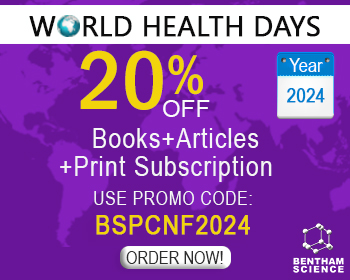Abstract
Background: Diabetes is a major public health problem in the world. It affects each and every part of the human body and also leads to organ failure. Hence, great progress is made in the field of herbal medicine and diabetic research.
Objectives: Our review will focus on the effect of bioactive compounds of medicinal plants which are used to treat diabetes in India and other countries.
Methods: Information regarding diabetes, oxidative stress, medicinal plants and bioactive compounds was collected from different search engines like Science direct, Springer, Wiley online library, Taylor and francis, Bentham Science, Pubmed and Google scholar. Data was analyzed and summarized in the review.
Results: Anti-diabetic drugs that are in use have many side effects on vital organs like heart, liver, kidney and brain. There is an urgent need for alternative medicine to treat diabetes and their disorders. In India and other countries, herbal medicine was used to treat diabetes. Many herbal plants have antidiabetic effects. The plants like ginger, phyllanthus, gymnea, aswagandha, aloe, hibiscus and curcuma showed significant anti-hyperglycemic activities in experimental models and humans. The bioactive compounds like Allicin, azadirachtin, cajanin, curcumin, querceitin, gingerol possess anti-diabetic, antioxidant and other pharmacological properties. This review focuses on the role of bioactive compounds of medicinal plants in the prevention and management of diabetes.
Conclusion: Moreover, our review suggests that bioactive compounds have the therapeutic potential against diabetes. However, further in vitro and in vivo studies are needed to validate these findings.
Keywords: Diabetes, medicinal plants, bioactive compounds, drug discovery, bioactive compounds, anti-diabetic drugs.
[http://dx.doi.org/10.2337/diacare.27.5.1047] [PMID: 15111519]
[http://dx.doi.org/10.2337/diacare.21.9.1414] [PMID: 9727886]
[http://dx.doi.org/10.1016/j.foodchem.2010.07.104]
[http://dx.doi.org/10.1016/j.fct.2010.12.013] [PMID: 21184796]
[http://dx.doi.org/10.1249/01.MSS.0000126576.53038.E9] [PMID: 15126709]
[http://dx.doi.org/10.1016/j.redox.2015.01.002] [PMID: 25588755]
[http://dx.doi.org/10.2174/1573399810666140606103645] [PMID: 24919657]
[http://dx.doi.org/10.1038/s41581-020-0278-5] [PMID: 32398868]
[http://dx.doi.org/10.5001/omj.2012.68] [PMID: 23071876]
[http://dx.doi.org/10.2174/1872213X12666180221161410] [PMID: 29473531]
[http://dx.doi.org/10.1080/10408398.2018.1434480] [PMID: 29388805]
[http://dx.doi.org/10.5604/17322693.1227896]
[http://dx.doi.org/10.1155/2013/918039] [PMID: 24191253]
[http://dx.doi.org/10.7150/ijms.5224] [PMID: 23471081]
[http://dx.doi.org/10.1248/bpb.b16-00137] [PMID: 27803448]
[http://dx.doi.org/10.1128/AEM.70.10.5750-5755.2004] [PMID: 15466510]
[PMID: 8877056]
[http://dx.doi.org/10.1038/nrneph.2011.51] [PMID: 21537349]
[http://dx.doi.org/10.1016/j.jep.2017.08.035] [PMID: 28864169]
[http://dx.doi.org/10.1016/j.phytochem.2007.04.039] [PMID: 17574636]
[http://dx.doi.org/10.3892/ijmm.9.1.77] [PMID: 11745001]
[http://dx.doi.org/10.1042/BST0351156] [PMID: 17956300]
[http://dx.doi.org/10.1016/j.psj.2019.10.009] [PMID: 32036959]
[http://dx.doi.org/10.1016/j.nut.2018.06.015] [PMID: 30278430]
[http://dx.doi.org/10.3233/CH-2011-1424] [PMID: 22240353]
[http://dx.doi.org/10.1016/j.bbadis.2014.10.013] [PMID: 25445538]
[http://dx.doi.org/10.1007/s00125-011-2064-1] [PMID: 21340626]
[http://dx.doi.org/10.1021/jf9811065] [PMID: 10794622]
[http://dx.doi.org/10.1039/C4FO00844H] [PMID: 25599885]
[http://dx.doi.org/10.17485/ijst/2009/v2i2.5]
[http://dx.doi.org/10.2174/138955708786140990] [PMID: 18855732]
[http://dx.doi.org/10.1111/j.1750-3841.2011.02116.x] [PMID: 22417336]
[http://dx.doi.org/10.1016/S1995-7645(12)60061-3] [PMID: 22546653]
[PMID: 25050289]
[PMID: 12470587]
[http://dx.doi.org/10.1016/j.febslet.2011.09.012] [PMID: 21944868]
[http://dx.doi.org/10.1515/znc-2013-5-603] [PMID: 23923614]
[http://dx.doi.org/10.1016/j.intimp.2014.05.030] [PMID: 24925757]
[http://dx.doi.org/10.2174/1871528112666131125110017] [PMID: 24266685]
[http://dx.doi.org/10.2174/0929867325666171206101945] [PMID: 29210634]
[http://dx.doi.org/10.2174/1389450116666151001105230] [PMID: 26424400]
[http://dx.doi.org/10.4103/0253-7613.81519] [PMID: 21713091]
[http://dx.doi.org/10.1016/j.jep.2003.09.028] [PMID: 15013182]
[http://dx.doi.org/10.1111/jcmm.13876] [PMID: 30324705]
[http://dx.doi.org/10.1016/j.biopha.2016.10.002] [PMID: 27810340]
[http://dx.doi.org/10.1016/j.jep.2017.12.045] [PMID: 29305899]
[http://dx.doi.org/10.1016/j.ijantimicag.2014.06.001] [PMID: 25130096]
[http://dx.doi.org/10.4103/0973-1296.191461] [PMID: 27761078]
[http://dx.doi.org/10.1016/0378-8741(88)90136-5] [PMID: 3199837]
[http://dx.doi.org/10.1016/0378-8741(91)90018-9] [PMID: 2056760]
[http://dx.doi.org/10.1007/BF00280886] [PMID: 3899826]
[http://dx.doi.org/10.1016/S0378-8741(01)00173-8] [PMID: 11297849]
[http://dx.doi.org/10.1078/09447110260573191] [PMID: 12403165]
[http://dx.doi.org/10.2174/1871525716666180103163107] [PMID: 29299990]
[http://dx.doi.org/10.1016/0378-8741(95)01329-6] [PMID: 8778502]
[PMID: 10919098]
[PMID: 9770212]
[http://dx.doi.org/10.1055/s-1999-14060] [PMID: 10364838]
[http://dx.doi.org/10.1177/2156587215595152] [PMID: 26187284]
[http://dx.doi.org/10.1093/ecam/nem029] [PMID: 18830445]
[PMID: 10356965]
[PMID: 29922422]
[http://dx.doi.org/10.1016/j.jep.2004.06.017] [PMID: 15374607]
[http://dx.doi.org/10.1186/1472-6882-3-4] [PMID: 12950994]
[http://dx.doi.org/10.1111/j.1464-5491.2012.03718.x] [PMID: 22671971]
[PMID: 1334043]
[PMID: 31516859]
[PMID: 3818036]
[http://dx.doi.org/10.1002/ptr.6381] [PMID: 31155769]
[http://dx.doi.org/10.1016/S0378-8741(00)00175-6] [PMID: 10940580]
[http://dx.doi.org/10.1016/j.phymed.2019.152906] [PMID: 31064680]
[http://dx.doi.org/10.1093/jn/128.12.2319] [PMID: 9868176]
[PMID: 1768783]
[PMID: 8005644]
[http://dx.doi.org/10.1016/0378-8741(90)90107-5] [PMID: 2259216]
[http://dx.doi.org/10.1016/j.biopha.2018.08.115] [PMID: 30257341]
[http://dx.doi.org/10.1016/j.jep.2005.02.024] [PMID: 15955648]
[http://dx.doi.org/10.1007/BF02873663]
[http://dx.doi.org/10.1016/0378-8741(92)90049-W] [PMID: 1434682]
[http://dx.doi.org/10.1007/BF02193851] [PMID: 2174154]
[http://dx.doi.org/10.4103/1319-2442.220880] [PMID: 29265038]
[http://dx.doi.org/10.1007/s12291-013-0404-2] [PMID: 25646044]
[http://dx.doi.org/10.1016/S0378-8741(02)00332-X] [PMID: 12648829]
[http://dx.doi.org/10.1016/S0378-8741(01)00337-3] [PMID: 11744290]
[PMID: 21686137]
[PMID: 8786163]
[http://dx.doi.org/10.1016/j.jep.2017.05.002] [PMID: 28483637]
[http://dx.doi.org/10.1016/j.etp.2011.05.003] [PMID: 21640568]
[http://dx.doi.org/10.1089/jmf.2006.9.108] [PMID: 16579737]
[http://dx.doi.org/10.1002/ptr.2476] [PMID: 18819164]
[http://dx.doi.org/10.1021/np9607013] [PMID: 9214733]
[http://dx.doi.org/10.1016/j.fct.2010.02.023] [PMID: 20178824]
[http://dx.doi.org/10.1016/j.nutres.2013.03.003] [PMID: 23684435]
[http://dx.doi.org/10.1016/S0378-8741(99)00105-1] [PMID: 10624898]
[http://dx.doi.org/10.4103/ayu.AYU_134_13] [PMID: 29200746]
[http://dx.doi.org/10.1002/jsfa.4345] [PMID: 21445856]
[http://dx.doi.org/10.7860/JCDR/2017/26563.10312] [PMID: 28892926]
[http://dx.doi.org/10.1155/2017/1083589] [PMID: 28572825]
[http://dx.doi.org/10.3109/13880209309082914]
[http://dx.doi.org/10.1016/S2221-1691(15)30173-8]
[http://dx.doi.org/10.1016/S0378-8741(03)00014-X] [PMID: 12639749]
[http://dx.doi.org/10.4103/0974-8490.110541] [PMID: 23798886]
[PMID: 10641146]
[http://dx.doi.org/10.1155/2010/841090] [PMID: 20652054]
[http://dx.doi.org/10.4103/1735-5362.202452] [PMID: 28515766]
[http://dx.doi.org/10.3945/jn.109.107631] [PMID: 19625702]
[PMID: 11116534]
[http://dx.doi.org/10.1186/s12906-018-2346-y]


























